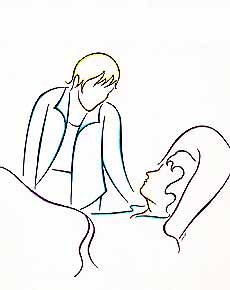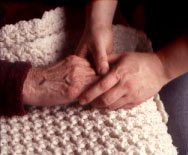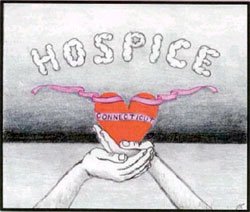|
Here’s
part of an article from www.nurseweek.com.
Our speaker for our Program on Feb. 25th will be Mary Jacobs from Assured Hospice of Clallam County. |
|
Circle
of Life |
 |
||||||||
| Jeanne pulls up in front of a seemingly
indistinct gray duplex on a block of tattered homes in San Jose, Calif.
She peers through the screen door and scans the room, looking for 11-year-old
Antonio. The boy appears to be nowhere in sight, until her eyes fasten
on a motionless lump on the couch. She enters, and prods Antonio gently.
His heavy eyes open briefly. Jeanne and the boy’s relatives smile
with nervous relief-and with good reason. Each of Antonio’s naps
could be his last. Doctors didn’t expect the boy to survive through
the week, and Jeanne, a hospice nurse, had been charged with making his
final days as enjoyable as possible. |
|||||||||
| Antonio
Cancilla was a candidate for a third heart transplant, but he had grown
to loathe the life confined to monitors and white walls. The sixth-grader
knew another heart wouldn’t fix his problem and finally confided
in his uncle that he didn’t want to go back to the hospital anymore.
Both were relieved when doctors introduced them to hospice, a program
that would shift the focus from finding a cure to enjoying Antonio’s
remaining days. Jeanne Fabricius [fah-BREE-she-us], RN, a nurse with Hospice
of the Valley in San Jose, was visiting twice a week to ensure that Antonio
wasn’t in pain and to check in with his uncle, who was the primary
caregiver. Like many hospice patients, Antonio and his uncle Anthony wished they’d known about hospice before the final weeks of the boy’s life. Other patients are driven away by misconceptions about this form of care. For some, it’s perceived as a dismal failure to conquer a disease. For others, it’s a place people go to die. Yet nurses such as Fabricius contend that this couldn’t be further from the truth. Hospice nurses see their mission as helping people to fully live their final days or months. The nurses interviewed by NURSEWEEK agreed that when families wait too long to seek hospice, it not only increases the acuity of the patient’s illness, but also severely limits the patient’s ability to fulfill their final wishes for connecting with loved ones. As a result, many hospice administrators are looking to the future with trepidation. They foresee an aging baby boomer population with increased acuity levels flooding hospice programs in the midst of a nursing shortage.
Now, more than 3,000 hospice programs operate throughout the country, and 96 percent of those programs provide routine home care, according to the National Hospice and Palliative Care Organization. In order to qualify for hospice, most programs follow Medicare’s requirement that a patient must have a prognosis of six months or less if the illness were to run its natural course. To help families cope with the reality of losing a loved one, hospice programs usually provide not only a nurse, but also a social worker, a chaplain and other volunteers who can do everything from massages to housecleaning. For many nurses who now work in hospice, this new philosophy is a brilliant alternative to the mentality they’ve seen in hospitals. “Hospice acknowledged that dying is as much a medical specialty as birth,” said Virginia Shubert, MN, CHPN, RN, executive director of Yolo Hospice in Davis, Calif. “It is about making dying a natural part of the life cycle. Dying is not a medical problem.” About 600,000 Americans died while in hospice care in 2000, which is about one out of every four deaths, according to the NHPCO. But hospice administrators expect this number to swell significantly as the baby boomers continue to age. Some hospices already are feeling the pressure because demand is increasing at the same time that nurses are harder to come by. Most hospice administrators agree that they have one advantage over hospitals: low turnover rates. Once nurses discover the hospice field, few leave. “It’s one of the places a nurse can do what he or she went to nursing school for in the first place,” said Klinghoffer, MA, RN, executive director of the hospice in San Jose. “In hospice, they have the tools, time, respect and support to be treated as professionals. They work independently and can make crucial decisions.” A secondary mission for hospice nurses is to offer support to caregivers who are often bewildered by a slew of new responsibilities. Consoling caregivers is a particularly crucial part of the job for Christy Torkildson, MSN, RN, coordinator of the pediatric palliative care program at University of Texas Health Science Center in San Antonio. She provides hospice-type care to children who are dying, and regularly sees just how much pain these parents experience. “Some parents do very well, but some have a hard time and it takes a long time to work through their grief,” she said. “The ones who do best are the ones who embrace the experience in some way and have support and spirituality.” In many cases, it’s the children who help the parents embrace the situation. Torkildson remembered one 13-year-old boy with bone cancer who recorded tapes for his little sister to open on special birthdays because he wouldn’t be there. There was also a 17-year-old girl who told her mother she’d die on her birthday because this way her mother would have to be sad only one day a year. She did. Torkildson also recounted the story of a 5-year-old girl who made a will and gave her favorite toys to specific people. There is something incredible about working with a 5-year-old who is concerned about others and is looking forward to being with the angels,” Torkildson said. “It’s like working with angels on earth.”
Death is more
universal than life; everyone dies but not everyone lives.
A. Sachs
|
|||||||||
| Spreading
the word Even though hospice care is a vivid experience for the nurses and families that use it, many people still are unaware that it’s an option. In response, hospice organizations often use a share of their resources to spread the word about their services. To educate families and doctors about the value of hospice, Elizabeth Ford Pitorak, MSN, APRN, CHPN, director of the Hospice Institute of Hospice of the Western Reserve in Cleveland, introduced a hospice team to Ireland Cancer Center in Cleveland, where patients receive aggressive chemotherapy. Before the team entered the center, about 13 percent of patients typically died under hospice care. The team spent about two years with patients and, by the end of the project, about 80 percent were dying under hospice care. Pitorak hopes these experiences left an impression on families and physicians about the importance of facing death before it’s too late. “There is hard work we need to do at the end of life,” she said. “We need to figure out what our meaning and purpose have been, maybe do reconciliation with someone.” Although it may mean giving up the search for a cure, Pitorak has seen the fruits of making this difficult decision. “I am absolutely amazed when patients say the last two months of their lives have been the best ones.” While hospice nurses are eager to point more people to the benefits of their services, increased awareness will likely heighten demand for RNs who provide hospice care. Kathy Egan, MA, CHPN, RN, vice president of The Hospice of the Florida Suncoast, works for an organization that’s experimenting with new ways to handle patient loads. One idea is to spread some of a nurse’s responsibilities to other people in the hospice team. For example, they could train volunteers to help patients with bathing or eating, rather than leaving these tasks to the nurse. This would free up nurses to focus on other responsibilities, such as pain management. The Florida hospice also is partnering with community organizations to train volunteers who can help hospice families with daily life, activities such as grocery shopping, cooking or providing respite for caregivers. “We need to plan ahead so we are ready to serve the future population, and these are ways to get more people helping,” Egan said. Contact Heather Stringer at heathers@nurseweek.com You can read more
at: |
|||||||||
|
|
SI Sequim |

